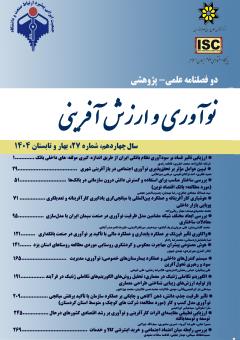هوش مصنوعی پیشران مهاجرت معکوس و گردشگری روستایی موردی مطالعه روستاهای استان یزد
محورهای موضوعی : یافته های جدید علمی در حوزه های نوآوری و کارآفرینی
اباذر اشتری مهرجردی
1
![]() ,
مهدی جم پور
2
,
مهدی جم پور
2
1 - استادیار گروه علم و فناوری، پژوهشگاه مطالعات فرهنگی، اجتماعی و تمدنی، تهران، ایران
2 - استادیار گروه مهندسی کامپیوتر دانشگاه صنعتی قوچان، خراسان رضوی، ایران
کلید واژه: خانه دوم, مهاجرت معکوس روستایی, مهاجرت معکوس فصلی, گردشگری روستایی,
چکیده مقاله :
مهاجرت معکوس و گردشگری روستایی به عنوان موضوع و پدیدهای نوظهور به شمار میآید؛ این مهاجرت نظیر سایر پدیدههای دوران معاصر، پیچیده و چندوجهی است. طی سالهای جاری مهاجرت معکوس، خاصه از نوع روستایی آن بسیار با اهمیت بوده و مهمترین هدف این تحقیق شناسایی پیشرانهای زیرساختی این پدیده در قالب هوشمصنوعی در استان یزد میباشد. روش تحقیق مورد استفاده روش ترکیبی «کمی و کیفی» و جامعه آماري شامل کلیه روستاهای دارای اسناد توسعه روستایی شهرستان میبد به تعداد 8 روستا که دو روستا مورد بررسی قرار گرفتند. یافتههای مدل swot نشان داد، وجود زیرساختهای ارتباطی نظیر اینترنت، شبکههای اجتماعی مجازی، بهرهگیری از تکنولوژیهای نو جهت کسب درآمد و حفظ امنیت، وجود زمينها و خانه هاي بزرگ موروثي جهت ساخت، حمايت شوراي اسلامي و دهياري و پائین بودن قیمت تمام شده ساخت به عنوان مهمترین نقاط قوت، مؤلفههای تعارضات اجتماعي– فرهنگي ميان ساكنين و مهاجرین، کمبود آب کشاورزی و آشامیدنی به خصوص در فصل تابستان و عدم همراهي همسر و فرزندان افراد به عنوان مهمترین نقاط ضعف، مؤلفه های مسافت کم تا مرکز شهرستان و استان، استفاده از تسهيلات با نرخ بهره كم، بازگشت جوانان و تحصیل کردهگان در قالب مهاجرت معکوس، امکان بهرهگیری بیشتر از فناورهای نوین در کسب و کار و زندگی با وجود جوانان تحصیلکرده و خوش نامی و اعتبار نام خطه یزد مهمترین فرصتها و مؤلفههای ایجاد روستاي تفريحي و فراغتي، امکان فشار بر منابع و امكانات روستا و رواج فرهنگ مدگرايي، مصرفگرايي در روستاها به عنوان مهمترین تهدیدها در زمینه مهاجرت معکوس شناسایی شد
Rural reverse migration is an emerging theme and phenomenon of which second homes are the most important; About half a century has passed since its re-emergence and expansion. During the current years, reverse migration, especially of rural type, is significant. The most crucial goal of this research is to identify the infrastructural drivers of this phenomenon in the form of artificial intelligence in Yazd province. The research method used is the combined method "quantitative and qualitative". The statistical population of this research includes all villages with rural development documents of Meybod city in 8 villages, two of which were surveyed. Findings indicate that the existence of communication infrastructure such as the Internet, virtual social networks, the use of new technologies to earn money and maintain security, the existence of extensive hereditary grounds and houses for construction, the support of the Islamic Council and Dehyari and the low cost of construction due to the existence of inherited land and low interest loans, as the most important strengths, components of socio-cultural conflicts between residents and migrants, lack of agricultural and drinking water, especially in summer and lack of companionship And the children of individuals as the most critical weaknesses, components of short distance to the center of the city and province, use of facilities with low interest rates, return of youth and educated in the form of reverse migration, the possibility of using new technologies in business and life Despite the educated and well-known youth and reputation of Yazd region, the most critical opportunities and components of creating a recreational and leisure village, the possibility of putting pressure on the resources and facilities of the village and the spread of fashion culture, consumerism in villages as the most important threats in reverse migration is identified
